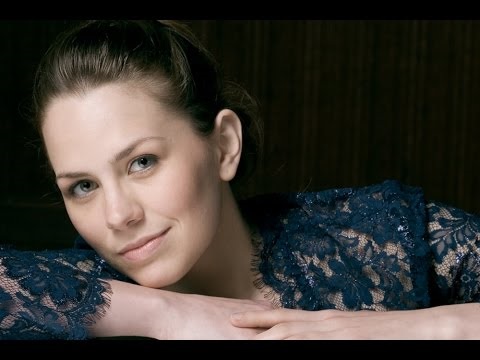 United States Vivaldi, Porpora, Fontana, Strozzi, Monteverdi: Erica Schuller (soprano), Brian Giebler (tenor); Olivier Brault, Alan Choo, Adriane Post, Carrie Krause (violin solos), Apollo’s Fire / Jeannette Sorrell (conductor). First United Methodist Church, Akron, Ohio, 13.2.2020. (MSJ)
United States Vivaldi, Porpora, Fontana, Strozzi, Monteverdi: Erica Schuller (soprano), Brian Giebler (tenor); Olivier Brault, Alan Choo, Adriane Post, Carrie Krause (violin solos), Apollo’s Fire / Jeannette Sorrell (conductor). First United Methodist Church, Akron, Ohio, 13.2.2020. (MSJ)

Vivaldi – Concerto in D major for 4 Violins RV549; Cianonna in C major RV114; Concerto in C major for 2 Violins RV507; ‘Vedrò con mio diletto’ from Giustino; ‘Summer’ from The Four Seasons Op.8 No.2
Porpora (arr. Sorrell) – ‘Alto Giove’ from Polifemo
Fontana – Trio Sonata No.8 in D major
Strozzi – ‘Che si può fare?’
Monteverdi – ‘Pur ti miro’ from L’Incoronazione di Poppea; ‘Fugge il verno’ and ‘Rosetta che Rosetta’ from Scherzi Musicale; ‘Ohimè, ch’io cado’
Apollo’s Fire refuses to let music lie dead on the page. Whether it’s from something as simple as creating a sense of occasion by entering the stage at the beginning of the concert (as opposed to the American tradition of players blandly practicing onstage a half-hour before curtain), or something as sophisticated as pushing the ornamentation and improvisation in a Monteverdi aria toward jazz style, Apollo’s Fire keeps the concert experience vital.
The Prometheus behind Apollo’s Fire is its founder and music director Jeannette Sorrell. While Sorrell repeats standard favorites from time to time, she has developed an audience that welcomes explorations of less familiar corners of the Baroque, whether through forgotten works by famous composers, or those worth hearing by lesser luminaries.
This concert contained three concertos by Antonio Vivaldi, only one of which is a ‘greatest hit,’ ‘Summer’ from The Four Seasons. Last year, Apollo’s Fire performed the whole cycle in an event celebrating twenty-five years of concertizing in Akron. On that occasion, the soloist for the first two concertos was Alan Choo, serving as an Artistic Leadership Fellow for 2019-20. While Choo was fine then, it was exciting to see how much his artistic grip, confidence, and sense of engagement with this ensemble has grown in just six months. With the continuo section led by cellist René Schiffer – who made sure that the musicians kept glued to any expressive variances in tempo that Choo introduced – they not only matched his precision, but also provoked him to more dramatic heights. Over it all, Sorrell presided like an alchemist working in human personalities. Choo and the sparkling violinist Emi Tanabe joined with the continuo forces for Giovanni Battista Fontana’s Trio Sonata No.8 in D.
In Vivaldi’s Concerto in D for four violins RV549 – the opener of the Op.3 L’Estro Armonico set – Sorrell paired the brighter-toned Olivier Brault and Adriane Post against the richer-toned Julie Andrijeski and Evan Few, as if assembling a sports team. Interestingly, the dotted-note slow movement is marked ‘Largo e spiccato’, though in the Baroque era, spiccato simply meant ‘separated’, as opposed to the modern bouncing bow technique. Convex baroque bows don’t bounce in the way that tightly strung modern bows do.
Brault and Post were paired again in the less familiar Vivaldi Concerto in C for two violins RV507. After a dramatic, dueling opening for the two soloists, the whole ensemble vigorously joined in. Post and Brault were well-matched, with similarly bright flamboyance. But Post has a distinctive way of suddenly pulling her sound back to an inward level that highlighted the exchanges between the two.
Seeking contrast, Sorrell paired Brault with Carrie Krause for her arrangement of the aria ‘Alto Giove’ from Nicola Porpora’s opera Polifemo. Krause was given the lovelorn vocal line, and she voiced it tenderly with her characteristically tawny sound. Brault entered from the wings as the voice of a flirtatious suitor, contrasting with Krause, yet interweaving intimately. The two also paired up for the Vivaldi Ciaconna in C major RV114.
Joining the ensemble for early Baroque masterpieces were singers Erica Schuller and Brian Giebler. Schuller was breathtakingly crystalline in the concert aria ‘Che si può fare?’ by Barbara Strozzi, an intriguing member of the early Baroque scene in Venice. The illegitimate daughter of a Venetian nobleman, she persevered in a career as musician and composer despite detractors who called her a courtesan. Judging by this passacaglia-based aria, Strozzi is due for rediscovery, as the expressive power here was nothing less than haunting, and Schuller didn’t hesitate to plumb its emotional depths. Happily, Sorrell noted that more Strozzi will be coming next season in a concert entitled Feminine Takeover 1601.
Schuller was joined by Brian Giebler in the aria ‘Pur ti miro’ from Monteverdi’s L’Incoronazione di Poppea. Giebler’s tenor was stylish and warm, though he didn’t have the vocal heft to match Schuller’s substantial soprano — lovely voices both, but as duet partners, their chemistry didn’t quite spark. But in selections from Monteverdi’s Scherzi Musicali, more ensemble-based and infectiously fun, the duo were found more joy.
Schuller returned in the second half for ‘Vedrò con mio diletto’ from Vivaldi’s Giustino, and her soprano flew high without any strain, somehow both gem-like and milky, as the ensemble supplied tenderly plucked notes. Schuller remained and joined in on the concert’s most surprising selection – surely calculated to raise purists’ blood pressure – Monteverdi’s ‘Ohimè, ch’io cado’, that started off straight but began to swing in rhythm more and more as it progressed, finally pushing past scholarly baroque notes inégales, to actual jazzy blue notes. Vocalist Schuller and solo violinists Tanabe and Choo joined in just as much as the continuo players, deliciously melting the walls of time, showing that the distant past is never that far gone after all.
Mark Sebastian Jordan